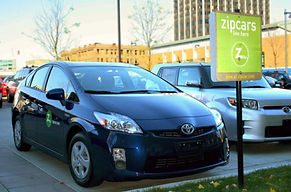
TRAVEL DEMAND
MANAGEMENT
Travel demand management (TDM) involves using a series of strategies to encourage the use of alternative methods or times of travel, with the goal of reducing traffic congestion and vehicle emissions. VISION 2050 recommends that the State, local units of government, and private businesses pursue the following TDM strategies to encourage the use of alternative travel times or travel modes.
KEY RECOMMENDATIONS
Enhance the preferential treatment for high-occupancy vehicles
Continue and enhance the preferential treatment for high-occupancy vehicles (HOVs): transit vehicles, vanpools, and carpools. This involves providing queue bypass lanes for vanpools, carpools, and buses at metered freeway on-ramps, and providing preferential carpool and vanpool parking at businesses and destinations. Additional measures include transit signal priority systems and reserved bus lanes along congested surface arterial streets and highways, which are discussed on the Public Transit page of this website.
Expand the network of park-ride lots
Promote carpooling and the resultant more efficient use of the Region’s transportation system by expanding the network of park-ride lots.

Price personal vehicle travel at its true cost
Increase the percentage of the costs of construction, maintenance, and operation of street and highway facilities and parking facilities borne by the users of those facilities, by implementing road user fees, cash-out of employer-paid parking, and parking pricing.
Much of the costs of constructing and maintaining county and local roads in the Region are paid through property taxes. Shifting these costs to increases in motor fuel taxes and considering a vehicle-miles traveled (VMT) fee, tolling, and/or congestion pricing to supplement or replace the motor fuel tax system, would result in users of county and local roads paying the costs, rather than property tax payers.
User fees can also encourage the use of alternative modes of travel, lessening the number of vehicles, and potentially the amount of congestion, on the arterial street and highway network.
Cash-out of employer-paid parking is a way the cost of parking facilities can be borne by their users. It involves employers charging their employees the market value of parking—rather than subsidizing the costs of parking facilities by providing free parking. Employees then have a choice to park at work, or to accept a cash payment or salary increase and give up the parking space. Parking cash-out encourages employees not to drive alone to work, because they could “pocket” the cash payment or salary increase.

Promote demand management, car sharing, and live near your work programs
Continue and expand the Commission's CommuteWISE program, which promotes transit use, bicycle use, ridesharing, pedestrian travel, telecommuting, compressed work weeks, and work-shift rescheduling, through education, marketing, and promotions aimed at encouraging alternatives to driving alone.
Also, expand car sharing services to reduce private vehicle ownership and support live near your work programs that provide down payment assistance, location efficient mortgages, and rent subsidies for people who buy or rent a home near their employer.
Facilitate transit, bicycle, and pedestrian movement in local land use plans and zoning
Facilitate transit, bicycle, and pedestrian movement as part of preparing and implementing detailed, site-specific neighborhood and major activity center land use plans. This includes encouraging development of mixed-use and higher-density neighborhoods with employment, shopping, parks, and other entertainment options nearby to facilitate biking and walking and reduce the need for residents to own or use a car.
Parking facilities can consume large amounts of land that could otherwise be developed, and can increase the costs of a development in mixed-use and high-density developments. VISION 2050 recommends local governments in urban areas consider removing minimum parking requirements from their zoning ordinances, instead allowing developers and businesses (i.e., the market) to determine the appropriate amount of parking required for an area.

Partner with private-sector mobility service providers
Emerging trends in shared-use transportation are rapidly evolving, with private-sector mobility providers that offer new services such as shared micromobility (e.g., bike and scooter share programs), app-based ride hailing (e.g., Uber and Lyft), on-demand carpooling, and other app-based mobility options. These new services have the potential to have both positive and negative impacts on the Region—from possibly reducing vehicle ownership and drive-alone personal vehicle travel to potentially posing safety hazards and increasing VMT. VISION 2050 recommends that local, county, and State agencies and units of government develop partnerships with private-sector mobility service providers to advance an equitable, affordable, and efficient transportation system in the Region.









